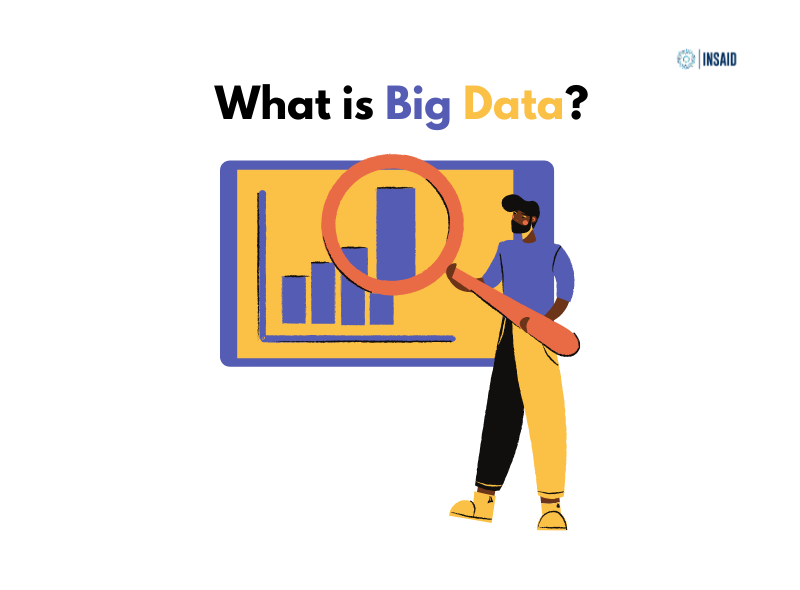With a spike in internet usage and other technologies such as IoT devices, mobile phones, autonomous devices like robotics, drones, vehicles, appliances, the volume of generated data is growing exponentially at an unprecedented rate. This constant increase in the amount of data generated has led to the emergence of big data.
So What Is Big Data?
Let’s keep it simple. Big data refers to a collection of data that is so huge and complex that none of the traditional data management tools are able to store it or process it efficiently. Now, do you know that big data involves lots of data? But have you ever stopped to think about just how big is big data?
According to Forbes, there are 2.5 quintillion bytes of data created every day. Now, you might be wondering how big data tools managed to handle such a huge amount of data?
When Netflix offers you personalized recommendations from its library of 1000s of movies and TV shows. That’s big data at work. Big Data helps Netflix determine which programs may be of interest to you and the recommendation systems actually influence 80% of the content we watch on Netflix.
In the near future. With the growing increase in the volume of data. Big data will grow bigger and the demand for data management experts will shoot up. The gap between the demand for data professionals and the availability will widen.

Why Is Big Data Important?
The importance of big data doesn’t simply revolve around how much data you have. The value lies in how you use it. By taking data from any source and analyzing it, you can find answers that:
1) Streamline resource management
2) Improve operational efficiencies
3) Optimize product development
4) Drive new revenue and growth opportunities
5) Enable smart decision making
When you combine big data with high-performance analytics, you can accomplish business-related tasks such as:
- Determining root causes of failures, issues and defects in near-real time.
- Spotting anomalies faster and more accurately than the human eye.
- Improving patient outcomes by rapidly converting medical image data into insights.
- Recalculating entire risk portfolios in minutes.
- Sharpening deep learning models’ ability to accurately classify and react to changing variables.
- Detecting fraudulent behavior before it affects your organization.
How Big Data Works
Before businesses can put big data to work for them, they should consider how it flows among a multitude of locations, sources, systems, owners and users. There are five key steps to taking charge of this “big data fabric” that includes traditional, structured data along with unstructured and semi structured data:
- Set a big data strategy.
- Identify big data sources.
- Access, manage and store the data.
- Analyze the data.
- Make intelligent, data-driven decisions.
As a bonus, check out this video to understand this concept in the most simplest manner.
1) Set a big data strategy
At a high level, a big data strategy is a plan designed to help you oversee and improve the way you acquire, store, manage, share and use data within and outside of your organization.
A big data strategy sets the stage for business success amid an abundance of data. When developing a strategy, it’s important to consider existing – and future – business and technology goals and initiatives. This calls for treating big data like any other valuable business asset rather than just a byproduct of applications.
2) Identify big data sources
- Streaming data comes from the Internet of Things (IoT) and other connected devices that flow into IT systems from wearables, smart cars, medical devices, industrial equipment and more. You can analyze this big data as it arrives, deciding which data to keep or not keep, and which needs further analysis.
- Social media data stems from interactions on Facebook, YouTube, Instagram, etc. This includes vast amounts of big data in the form of images, videos, voice, text and sound– useful for marketing, sales and support functions. This data is often in unstructured or semi structured forms, so it poses a unique challenge for consumption and analysis.
- Publicly available data comes from massive amounts of open data sources like the US government’s data.gov, the CIA World Factbook or the European Union Open Data Portal.
- Other big data may come from data lakes, cloud data sources, suppliers and customers.
3) Access, manage and store big data
Modern computing systems provide the speed, power and flexibility needed to quickly access massive amounts and types of big data.
Along with reliable access, companies also need methods for integrating the data, building data pipelines, ensuring data quality, providing data governance and storage, and preparing the data for analysis.
Some big data may be stored on-site in a traditional data warehouse – but there are also flexible, low-cost options for storing and handling big data via cloud solutions, data lakes, data pipelines and Hadoop.
4) Analyze the data
With high-performance technologies like grid computing or in-memory analytics, organizations can choose to use all their big data for analyses. Another approach is to determine upfront which data is relevant before analyzing it.
Either way, big data analytics is how companies gain value and insights from data. Increasingly, big data feeds today’s advanced analytics endeavors such as artificial intelligence (AI) and machine learning.
5) Make intelligent, data-driven decisions
Well-managed, trusted data leads to trusted analytics and trusted decisions. To stay competitive, businesses need to seize the full value of big data and operate in a data-driven way– making decisions based on the evidence presented by big data rather than gut instinct.
The benefits of being data driven are clear. Data-driven organizations perform better, are operationally more predictable and are more profitable.
This will help data scientists and analysts draw high salaries. So what are you waiting for? Driving to the world of big data and towards a brighter future? Start learning this trending technology using Accredian’s expertly curated courses.
 Pin
PinIf you liked reading this blog and would love to explore more content like this, check out our blog page, especially curated for you!






